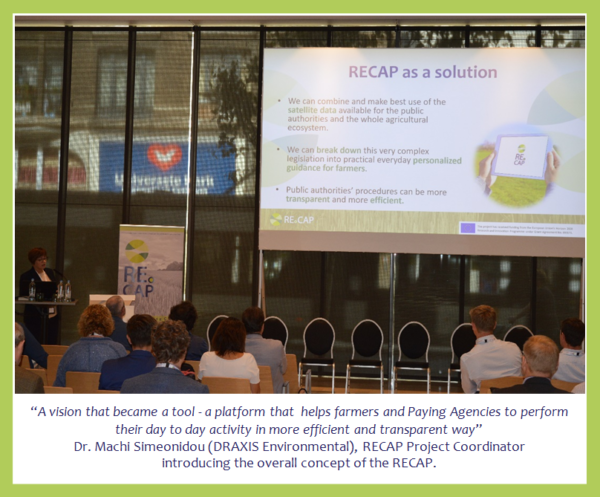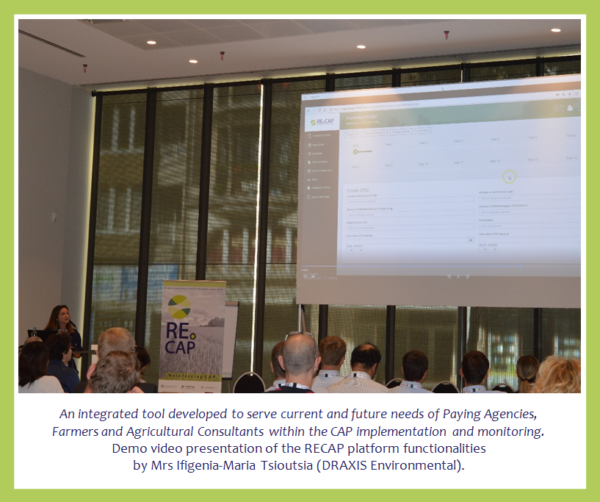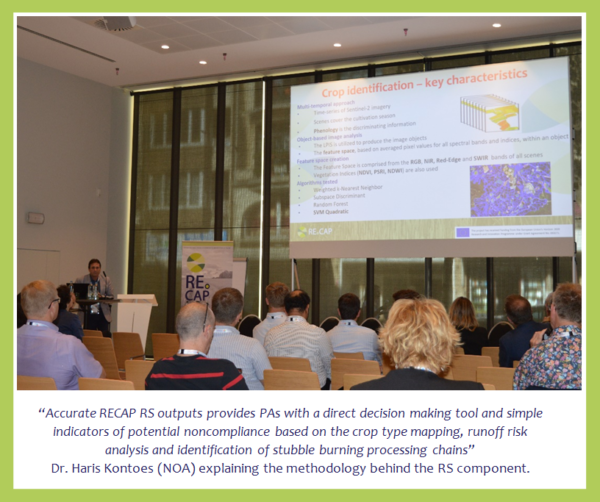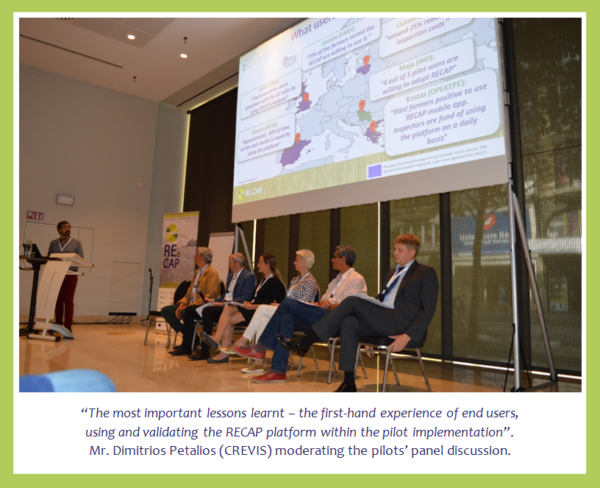Over the past 30 months, the European Research and Innovation H2020 project RECAP – “Personalised Public Services in Support for the implementation of the Common Agriculture Policy” intensively researched how the use of open satellite and user-generated data can support the implementation of CAP and increase efficiency and transparency between public administrators and farmers. As an outcome of the project, the RECAP platform has been developed, which is a unique tool that improves remote monitoring of CAP obligations, tailored to the farmers’, consultants’ and Paying Agencies’ needs.
On the 19th of September the RECAP project consortium hosted the final workshop of the project within the INSPIRE conference in Antwerp, having the opportunity to share experiences and present project results to a broad audience of stakeholders. Among other, several representatives of EU and national public institutions as well as farmers representatives and experts from the EO industry attended and actively participated in the open discussion of the workshop.
The workshop commenced with an introduction to the main challenges RECAP came to meet and the overall approach of the integrated system delivered transforming knowledge, Earth Observation & user-generated data into added value services for CAP monitoring.

Being the main integrated tool, the RECAP platform presentation followed, outlining the overall architecture, technologies and approaches used for the development of user driven (co-produced with end-users) personalized services supporting a better monitoring of the CAP for all the three main beneficiaries.

A focal point of the discussions was the Remote Sensing component of the RECAP platform and the results delivered within the testing and pilots implementation. Several interventions and questions from the audience focused on the technical aspects of the Remote Sensing tool and functionalities. The main points introduced, during the presentation of the Remote Sensing component and the Q&A session, were the following.
The RECAP team initially elaborated on the fundamentals of the component describing it as a set of automated earth observation processing workflows for the assistance to the paying agency performing on-the-spot checks. The overall remote sensing system is founded on the accurate crop type classification, applying machine learning techniques on Sentinel-2 data time-series. It was then clearly highlighted that the practicality of the output remote sensing information ranges from direct decision making (e.g. for Greening 1) to simple indicators of potential noncompliance (e.g. for GAEC 4 and GAEC 5).
The presented validated results revealed an overall crop type mapping accuracy in the range 80-90% for the identification of 9-13 different crop types, depending on the case study, which explain 80-90% of the regional agricultural zone. It was also shown that the algorithm provides satisfactory results, namely 75-85% accuracy, even for datasets that include satellite imagery only until mid-late June. This was marked as a very important realization, given paying agencies require accurate information early in the year to better target their on-the-spot inspections to the high risk cases.

Addressing technical questions regarding the limitations and dependencies of the employed methods, it was explained that the crop type classification accuracy mainly depends on three parameters, namely the percentage of truthful declarations, the cloud coverage and the parcel size. When a considerable percentage of declarations are not truthful, then similar crop types, both in spectral characteristics and phenology—e.g. wheat, barley, oats—might not be well discriminated. Hence, merging of such crop types into spectrally coherent clusters (e.g. cereals) would be necessary for an adequately accurate classification. Regarding the parcel size, it was suggested that as a rule of thumb parcels larger than 0.4 ha one can have confident crop type estimations.
A common question from the audience was in regard to the suitability of Sentinels and their 10 m spatial resolution for the monitoring policy of the new CAP. It was clarified that the Sentinel-2 mission introduces a paradigm shift in the quality and quantity of open access Earth Observation (EO) data, opening a new era for operational terrestrial monitoring systems, a fortiori in the agriculture sector. The mission offers unprecedented 10 m and 20 m spatial resolution data at a 5-day revisit time with twin satellites. Therefore, it is the first time that data are freely provided and systematically received over very large areas that range beyond the limits of one region or a country.
Given specific challenges and limitations the RS results provided are very promising for a more efficient and targeted risk assessment within the CAP monitoring. The current RECAP solution offers an integrated system of remote sensing information combined with auxiliary user-generated data (i.e. geo tagged images) enabling a more reliable, faster and cost-efficient inspection process. As a follow up to our Remote Sensing study in RECAP, we seek to extend and improve our methods towards the envisaged monitoring-based control of the CAP. The scientific literature and our RECAP experience emphatically suggest the exploration of data fusion techniques to utilize data from multiple sources, such as SAR (Sentinel-1). Therefore, it is aimed to move on to a more sophisticated model that also exploits ancillary features such as coherence and polarimetry from radar data. This is a work towards making the suggested scheme purely geography agnostic, with accurate and actionable remote sensing information even for regions of extended cloud coverage and unfavorable weather conditions.

Pilot partners shared with the audience their experience in testing and validating the integrated RECAP platform and services, also transferring the experiences of farmers using the RECAP solutions as day-to-day tools.
Most of the farmers that participated in the pilots, identified as the most helpful functionality of the RECAP platform the receipt of simple advice tailored on each of the cross compliance and greening rules applying to every single plot they have declared. Such “personalized” information provided in an easy to understand way and simple language, helps farmers to save time and concentrate more in to their farming activity. This approach has been the foundation upon which the RECAP platform is developed, paving the way towards a guidance based system supporting farmers to understand CAP rules and comply with them, than penalizing them for non-compliance.

Agricultural consultants and advisors also identified this functionality as very helpful for farmers but also as a tool for direct communication and provision of e-advice to farmers. “UK pilot farmers benefited from the RECAP platform providing them with simple advice, just on the rules they have to comply with. The mapping functionality was also very useful”, Dr Jason Beedell (Strutt & Parker) on the experience from the UK pilot case.
Using the Remote Sensing results advisors can inform farmers and correct any mistakenly declared plots, correct plot borders and any other mistakes which might cause potential non-compliance upon inspection.
As mentioned by the Greek Paying Agency representative – Mr Kostas Kountouris (OPEKEPE), “Greek pilot farmers are more interested in the RECAP mobile app, considering it very useful tool for the provision of personalized advice on the rules to comply with and receipt of reminders for compliance activities”.
Ms Gintare Kucinskiene (LAAS) representing the Agricultural Advisory Services of Lithuania, highlighted that “more than three quarters of the farmers participated in the Lithuanian pilot case are willing to keep using the RECAP platform as a day-to-day tool”.
Similarly in Serbia, 80% of all pilot users (farmers and organic certification bodies) are willing not only to adopt the RECAP platform but are also ready to pay for using it in the future. However the low level of famers ICT literacy was identified as limiting factor for higher adoption of the RECAP tools, as reported by Ms Maja Budimir (INO). The Serbian pilot case focused on supporting the administrative monitoringof the organic subsidy scheme, as this scheme is similarly structured and monitored as the CC rules under the CAP.The RECAP platform (all components except for the RS one) was adapted to support of the entire process of subsidy provision aiming at supporting all respective end users: organic farmers, certification bodies and the Serbian Paying Agency – Directorate for Agrarian Payments. All pilot users showed a great interest in using the platform incorporating also the RS component, which was not part of tools pilot tested, further enhancing a more efficient process of providing the organic subsidies through a digitised administrative control.
The RECAP platform will ensure efficiency, clarity and transparency of the necessary controls (OTSCs). Inspectors of the Lithuanian Paying Agency (NMA) estimated that using the RECAP platform the time spent on each inspection is reduced by almost one hour. The use of the RECAP platform and more specifically the Remote Sensing component contributes to an overall reduction of the cost for on the spot checks performed, by 25%. “Currently 2.600 on- the-spot controls on CC are performed per annum (average), on a cost of EUR 100 per control. According to our estimation, the use of the Remote Sensing component will reduce the overall time and cost by 25%, leading to savings of 65.000 EUR per year”, Mr Liutauras Simkus (NMA) mentioned in his intervention.
For the RECAP team, this final workshop was not an ending point. On the contrary it is seen as a starting point, for new initiatives for the delivery of user-driven solutions and added value services within the CAP monitoring.
Presentations of the RECAP final workshop can be found here.
SOURCE: www.recap-h2020.eu
